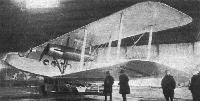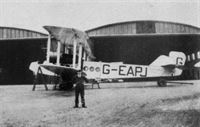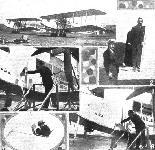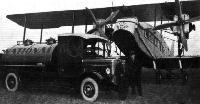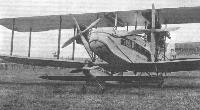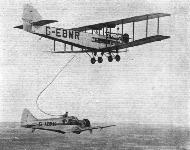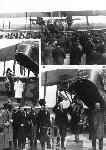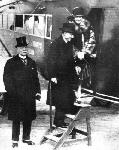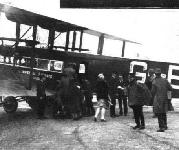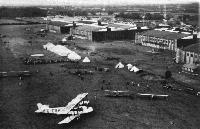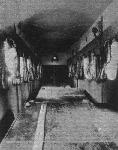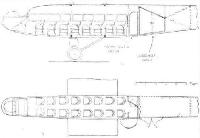
Описание
Страна : Великобритания
Год : 1919
Транспортный самолет с экипажем из двух человек
Варианты
- Handley Page - H.P.18 (W.8) / H.P.30 (W.10) - 1919 - Великобритания
- Handley Page - Hyderabad/H.P.24 / Hinaidi/H.P.33 / Clive/H.P.35 - 1923 - Великобритания
- Handley Page - Hamilton W.8e/H.P.26 / Hampstead W.9/H.P.27 - 1924 - Великобритания
Handley Page H.P.18, H.P.26, H.P.27 и H.P.30 (Type W.8, Type W.9 и Type W.10)
У военного бомбардировщика O/400 имелись внутренние распорки фюзеляжа, что делало его непригодным для использования в качестве гражданского транспортного самолета. Специалисты компании "Handley Page" решили перепроектировать эту машину в вариант, первоначально обозначенный как W/400 (H.P.16 в системе обозначений 1924 года). Новая машина имела фюзеляж другой конструкции, позволявший устанавливать до восьми пар кресел с центральным проходом, крылья бипланной коробки - от модели V/1500, но уменьшенного размаха, шасси - по типу самолета V/1500. В состав силовой установки включили два двигателя Rolls-Royce Eagle VIII. Первый полет состоялся 22 августа 1919 года, последующие летные испытания подтвердили достаточно высокую прочность выбранной конструкции. Однако было решено внести ряд усовершенствований и установить на серийных самолетах более мощные двигатели. Так появился прототип W.8 (H.P.18), оснащенный двумя W-образными двигателями Napier Lion IB мощностью по 450 л. с. и отличавшийся бипланной коробкой меньшего размаха (вместо 25,91 м стало 22,86 м), а также некоторыми изменениями в конструкции хвостового оперения. Свой первый полет самолет совершил 4 декабря 1919 года, а 4 мая 1920 года он поднялся на высоту 4276 м с полезной нагрузкой 1674 кг - в то время это было рекордом Великобритании.
После W.8 появились четыре серийных W.8b, в которых в полностью застекленной кабине размещались 16 пассажиров, а пилот и второй пилот находились в открытой кабине в носовой части. Ввиду трудностей с поставкой двигателей Lion на этих самолетах снова были установлены двигатели Eagle VIII, поэтому количество пассажиров пришлось сократить до 12. Три самолета использовались авиакомпанией "Handley Page Transport", один - поставлен бельгийской "Sabena", а уже впоследствии еще три транспортных W.8b были построены для "Sabena" компанией SABCA (Бельгия). Самолет W.8c являлся вариантом, выпущенным в 1923 году, с двигателями Eagle IX.
<...>
Самолет W.10 (H.P.30) - последний гражданский вариант, четыре экземпляра которого были построены компанией "Handley Page" для "Imperial Airways" в 1926 году, последний из них эксплуатировался до 1933 года, на самолетах устанавливались два двигателя Napier Lion IIB мощностью по 450 л.с.
Описание:
- Handley Page H.P.18, H.P.26, H.P.27 и H.P.30 (Type W.8, Type W.9 и Type W.10)
- Flight, December 1919
THE PARIS AERO SHOW 1919 - Flight, January 1920
The Handley Page W 8 - Flight, July 1920
The Olympia Aero Show 1920 - Flight, January 1922
THE HANDLEY PAGE W.8B. - Flight, November 1922
THE HANDLEY PAGE W 8C
Фотографии
-
Мировая Авиация 149
Регистрационный номер: G-EAPJ [6] Прототип W/8 "Ньюкасл", позднее получивший имя "Герцогиня Йорка" (рег. G-EAPJ), стал родоначальником серии удачных коммерческих авиалайнеров 20-х гг. прошлого века. Он воплотил в себе ряд конструктивных элементов O/400 и V/1500. Находясь в эксплуатации HPT, этот самолет разбился 10 июля 1923г. при выполнении аварийной посадки в Пуаси, недалеко от Парижа. Самолет сфотографирован с первоначальным вариантом хвостового оперения.
FINE RECORD: Handley Page (H.P.18) W.8 (Reg: G-EAPJ) powered by two 450-h .p. Napier Lions, which recently established a British record by lifting a useful load of 3,690 lbs. to an altitude of (official) 13,999 ft. We have no official information as to whether it was the barograph or the e.g. of the machine, or the e.g. of the useful load which reached this altitude. The duration of the flight was 1 hour 20 minutes -
Air Pictorial 1978-01 / E.Rees - Handley Page W.8 /Prototypes & Experimentals/
Регистрационный номер: G-EAPJ [6] Handley Page's first purpose-built civil transport, W.8 G-EAPJ first flew at Cricklewood on 2nd December 1919. Only one example was built
-
Aeroplane Monthly 1983-10 / J.Stroud - Wings of Peace
Регистрационный номер: G-EAPJ [6] THE NEW HANDLEY PAGE W.8 BIPLANE: For some considerable time there have been rumours of a new type of H.P. which was going to surpass anything hitherto seen in the way of luxury and comfort. The machine is now an accomplished fact, as will be seen from our photograph, and for once rumour has not been far from the truth. The new H.P., which is fitted with two 450 h.p. Napier Lions, is smaller and faster than the War types, and has a magnificent saloon cabin seating from 15 to 20 passengers. A feature of this is that there is no transverse cross bracing, so that the passengers have ample room to move about, while, if the machine be used for the carrying of cargo, the space available is 470 cub. ft. The machine has a maximum speed of 112 m.p.h., and a cruising speed of 90 m.p.h., while the landing speed is as low as 45 m.p.h. After a short test flight of only 20 minutes' duration, the machine was flown to Paris in 2 hours 10 minutes.
Handley Page W.8 G-EAPJ photographed in December 1919 shortly after its first flight on December 4. -
Flight 1921-11 / Flight
THE HANDLEY PAGE W8. - Our photograph shows this machine, which has two Napier "Lion" engines, starting off for its first flight to Paris, which was made in two hours five minutes.
-
Flight 1920-01 / Flight
A study in contrasts: The little 10 h.p. de Marcay “Passe-Partout" standing under the wings of the Handley Page W 8 at Le Bourget Aerodrome
Другие самолёты на фотографии: De Marcay Passe-Partout - Франция - 1920
-
Aeroplane Monthly 1983-10 / J.Stroud - Wings of Peace
Регистрационный номер: G-EAPJ [6] Handley Page W.8 G-EAPJ in the Grand Palais in December 1919. G-EAPJ was lost after a crash landing at Poix, Northern France on July 10, 1923.
-
Flight 1920-01 / Flight
THE PARIS AERO SHOW: may be seen the Handley Page, the Liore et Olivier and the Caproni
Другие самолёты на фотографии: Breguet Br.18 Berline / Br.14T - Франция - 1919Liore et Olivier LeO H.6 - Франция - 1919
-
Flight 1920-07 / Flight
A RECORD BREAKER AT OLYMPIA: The Handley Page W 8 which reached an altitude of 14,000 ft. with a load of 3,690 lbs.
-
Flight 1920-01 / Flight
The Handley Page, seen from above: In the large machine class, this was probably the finest all-round cabin ’bus in the exhibition
-
Flight 1920-02 / Flight
THE NAPIER LION: View from above, showing installation in a Handley Page W 8
-
Flight 1920-10 / Flight
AT WADDON: The Handley Page W8, winner of First Prize in Air Ministry Competition.
-
Aeroplane Monthly 1978-02 / Personal album
Регистрационный номер: G-EAPJ [6] Handley Page W.8 G-EAPJ was a rebuild of an H.P.W.4. It was operated by Handley Page Transport Ltd on the London-Paris run and was named Newcastle, but later became Duchess of York. 'PJ crash-landed at Poix in Northern France on July 10, 1923.
-
История Авиации 2003-03 / С.Корж - Коммерческая авиация /Ретроспектива/ (8)
Регистрационный номер: G-EAPJ [6] -
Flight 1920-10 / Flight
AT WADDON: The machine arriving at Waddon
-
Flight 1923-02 / Flight
AIR CONFERENCE VISIT TO WADDON: A Handley Page W.8.B, with Rolls-Royce "Eagle" engines, takes up visitors.
-
Flight 1939-06 / Flight
Stages in the evolution of commercial aircraft. The W.8B;
-
Flight 1922-04 / Flight
THE HANDLEY PAGE W.8B: Three-quarter front view.
-
Flight 1922-04 / Flight
THE HANDLEY PAGE W.8B: Front view.
-
Aviation Historian 18 / N.Stroud - A Grand Day Out at Chateau D'Ardenne
Регистрационный номер: OO-AHJ By far the largest aircraft to attend the rally in August 1930 was SABCA-built Handley Page W.8 OO-AHJ of Sabena. Seen here beside it at the airfield are, from left to right; M I. Renard, Director of Sabena; Mme J. Coomans; Col and Mme J. Smeyers; Mme Cocquyt; M Calembert; Capt Prosper Cocquyt (Sabena’s chief pilot) and M Regout.
-
Flight 1922-04 / Flight
View of the mounting of one of the Rolls-Royce "Eagle" engines in the Handley Page W.8B.
-
Flight 1922-04 / Flight
Регистрационный номер: G-EBBG [5] THE HANDLEY PAGE W.8B: Three-quarter rear view.
-
Aeroplane Monthly 1983-10 / J.Stroud - Wings of Peace
Регистрационный номер: G-EBBG [5], G-EBBH [5] W.8bs G-EBDG and ’BH at Croydon on May 16, 1922.
-
Flight 1939-06 / Flight
Регистрационный номер: G-EBBG [5], G-EBBH [5] THE HANDLEY PAGE W.8B: This machine was a 14-passenger, twin-engined (Rolls-Royce "Eagle") biplane, originally in service with Handley Page Transport, in 1922.
Typical machines at Waddon, alias Croydon, in 1922. Two Handley Page Transport W.8Bs - a picture taken when this type, a development of the O/400 bomber and the W.8., first went into service -
Flight 1922-05 / Flight
Регистрационный номер: G-EBBG [5], G-EBBH [5] "LAUNCHING" TWO HANDLEY PAGE W.8B BIPLANES: On May 16 two of the new W.8B's to be put on Vhe London-Paris air service were christened by Major-General Sir Sefton Brancker, the new Director of Civil Aviation. The names of the two machines are "Princess Mary" and "Prince George." Our Photographs show - 1 The two machines before the christening. 2. Mr. Handley Page and, in the doorway of the machine, the D. of C.A. 3. Sir Sefton Brancker breaks a bottle of champagne on the first machine and (4) tears off the strip which covers the name. In 5 Lieut.-Col. Barrett-Lennard is seen explaining some of the details to Sir Sefton Brancker.
-
Jane's All the World Aircraft 1980 / Encyclopedia of Aviation - 1. Chronology
Регистрационный номер: G-EBBG [5] A W.8 airliner of Handley Page Air Transport at Croydon (31 March 1921).
-
Aeroplane Monthly 1988-02 / Personal album. Civil
This Handley Page W.8b of Handley Page Transport Ltd is pictured on June 13, 1922 on the day it was used to fly a group of women on a rose-selling expedition to Paris. Gordon Olley can be seen suitably attired.
-
История Авиации 23 / С.Корж - Коммерческая авиация /Ретроспектива/ (9)
Регистрационный номер: G-EBBH [5] Ранее принадлежавший HPT W/8b "Принц Георг" передается новому хозяину, "Империал Эйруэйз".
-
Aeroplane Monthly 1993-04 / C.Prower - From Brisfit to Beverley (1)
Регистрационный номер: G-EBBI [14] 28 апреля 1924г.: на линии Лондон-Париж начала работать компания "Imperial Airways". Она объединила "Handley Page Aerial Transport", "Daimler Airways", "Instone Airlines" и "British Marine Air Navigation", став одним из предшественников нынешней "British Airways".
Handley Page W.8b G-EBBI Prince Henry, chartered by Capt Edward Fielden and used for joyriding. The photograph was taken in January 1928 by which time Imperial Airways' silver and dark blue livery had replaced the 1924 scheme with blue fuselages and white lettering. -
Aeroplane Monthly 1991-05 / Personal album. Civil
Регистрационный номер: G-EBBI [14] This view of G-EBBI shows the open cockpit - passengers were carried in the comparative comfort of an enclosed cabin! Note the proximity of the massive four-bladed wooden propellers, driven by 360 h.p. Rolls-Royce Eagle VIII engines. The aircraft is doped silver overall with black trim, the Imperial Airways livery of the period.
-
Aeroplane Monthly 1991-05 / Personal album. Civil
Регистрационный номер: G-EBBI [14] "Darling, I shan't be long, just going for a quick spin”
-
Aeroplane Monthly 1974-01 / P.Moss - Wings for the Empire (1)
Регистрационный номер: G-EBBI [14] H.P.W8b, G-EBBI, of HPT and named Prince Henry. It carried fifteen passengers and operated on the London-Belgium service.
-
Aeroplane Monthly 1991-05 / Personal album. Civil
Регистрационный номер: G-EBBI [14] Passengers boarding Prince Henry. Note the open windows.
-
Aeroplane Monthly 1990-12 / Personal album. Civil
Регистрационный номер: G-EBBI [14] Skipton, October 1932. On the left may be seen Avro 504K G-EBYW of Aviation Tours. On the right is Handley Page W.8b G-EBBI, owned by Imperial Airways but used during 1932 by Earl Fielden of Aviation Tours Ltd and flown by him with Cobham.
Другие самолёты на фотографии: Avro Avro 504 - Великобритания - 1913
-
Мировая Авиация 149
Регистрационный номер: G-EBBI [14] Крылья Heyford выполнялись из металла, с полотняной обшивкой, а металлический фюзеляж был покрыт обшивкой из легкого сплава и полотна. Экипаж - четыре человека, шасси - неубирающееся с хвостовым колесом.
-
Flight 1926-03 / Flight
Регистрационный номер: G-EBBI [14] HOME FROM THE CAPE: These three photographs tell the story of the home-coming of Cobham, Elliott and Emmott on Saturday of last week from their flight to Cape Town and back in a D.H.50 fitted with Armstrong-Siddeley "Jaguar" radial air-cooled engine. The photograph shows the D.H.50 arriving over Croydon aerodrome, followed by some of its escorting machines.
Другие самолёты на фотографии: De Havilland D.H.32 / D.H.34 - Великобритания - 1921De Havilland D.H.50 - Великобритания - 1923
-
Aeroplane Monthly 1989-12 / R.Bentley - Swiftly with Shell
Регистрационный номер: G-EBBI [14] An aerial view of Baldonnel aerodrome, Dublin taken in August 1931 on the occasion of the first Air Pageant there since 1911. The Handley Page W.10 G-EBBI in the foreground was joyriding throughout the meeting, piloted by Capt E. B. “Mouse" Fielden.
-
Aeroplane Monthly 1983-10 / J.Stroud - Wings of Peace
Регистрационный номер: O-BAHK Sabena’s Handley Page built W.8b at Brussels.
-
Air-Britain Archive 1980-01
Регистрационный номер: O-BAHM Passengers boarding O-BAHM (101) a SABCA-built Handley Page W.8e of SABENA.
-
Aeroplane Monthly 1984-06 / J.Stroud - Wings of Peace
Imperial Airways' G-EBBY at Brussels, with a Farman Goliath and a Sabena Handley Page W.8b in the background.
Другие самолёты на фотографии: De Havilland D.H.32 / D.H.34 - Великобритания - 1921Farman F.60 Goliath / F.169 - Франция - 1918
-
Aeroplane Monthly 1984-06 / J.Stroud - Wings of Peace
Another view of Daimler's G-EBBS, photographed this time at Croydon (Plough Lane), with the Handley Page W.8b Prince Henry and two Farman Goliaths in the background.
Другие самолёты на фотографии: De Havilland D.H.32 / D.H.34 - Великобритания - 1921Farman F.60 Goliath / F.169 - Франция - 1918
-
Aeroplane Monthly 1983-10 / J.Stroud - Wings of Peace
Регистрационный номер: G-EBIX [2] The W.8f G-EBIX after conversion to the twin-engined W.8g.
-
Flight 1929-11 / Flight
Регистрационный номер: G-EBIX [2] NEW WINE IN OLD BOTTLES: A Handley Page biplane which has been fitted with Rolls-Royce "F" engines.
-
Flight 1931-10 / Flight
Регистрационный номер: G-EBMM [10] THE HANDLEY PAGE W.10: This was a 1926, an improved model of the original W.8B. The engines, however, were Napier "Lions."
-
Aeroplane Monthly 1983-10 / J.Stroud - Wings of Peace
Регистрационный номер: G-EBMM [10] The W.10 G-EBMM in Imperial Airways' dark blue livery at Cricklewood early in 1926.
-
Air Pictorial 1957-02
Регистрационный номер: G-EBMM [10] Handley Page W.10, G-EBMM of Imperial Airways.
-
Aeroplane Monthly 1991-11 / Personal album. Civil
Регистрационный номер: G-EBMM [10] Originally owned and operated by Imperial Airways and named City of Melbourne, Handley Page W.10 G-EBMM was sold to National Aviation Day Displays Ltd (NADD) in November 1933 and, based at Ford, was renamed Youth of New Zealand. The W.10 is pictured at Woodford on June 10,1933. Later that year the aircraft was converted to a tanker for flight-refuelling experiments with an Airspeed Courier for an attempted non-stop flight to India on September 24, 1934. Its job done, the tanks were removed and 'MM was flown to continue pleasure-tripping with NADD. During the flight the aircraft suffered structural failure and it was destroyed in the subsequent crash near Aston Clinton.
-
Aeroplane Monthly 1974-02 / P.Moss - Wings for the Empire (2)
Регистрационный номер: G-EBMM [10] The new Croydon terminal in 1928. Posed in front are a W.10, Argosy and W.8b of I.A.L.
Другие самолёты на фотографии: Armstrong Whitworth Argosy - Великобритания - 1926
-
Aeroplane Monthly 1980-11 / R.Williams - Atalanta (2)
Регистрационный номер: G-EBMM [10] Imperial Airways' Atalanta G-ABTG Amalthea, seen at Croydon, with three engines running. Note the H.P.W10 G-EBMM in the hangar. Amalthea was later to crash at Kisumu, Kenya, in July 1938.
Другие самолёты на фотографии: Armstrong Whitworth Atalanta / A.W.15 - Великобритания - 1932
-
Flight 1932-04 / Flight
The fuel supply is of paramount importance on a tour like this, and throughout this National Benzole lorry will accompany the outfit to each aerodrome.
-
Flight 1927-08 / Flight
GET YOUR MAGNIFYING GLASSES OUT: The D.H. "Tiger-Moth" (D.H. engine) takes shelter under the Imperial Airways Handley Page air liner, "City of Melbourne," which spent a busy time at Hucknall taking up passengers.
Другие самолёты на фотографии: De Havilland Tiger Moth / D.H.71 - Великобритания - 1927
-
Flight 1926-02 / Flight
Регистрационный номер: G-EBMM [10] THE HANDLEY PAGE W.10 IN FLIGHT: These four views, taken at Cricklewood recently, show the new H.P. machine in various attitudes during a test flight. The pilot on this occasion was Capt. Hubert Broad.
-
Авиация и Космонавтика 2020-07 / Ю.Кузьмин - Дозаправка в воздухе: от первых опытов к первому в мире беспилотному заправщику
Регистрационный номер: G-EBMM [10] Handley Page W10 G-EBMM refuels Sir Alan Cobham's Airspeed Courier, G-ABXN, during the ill-fated record flight to India in 1934. After refuelling the Courier on September 22, the W10 broke-up in mid-air and crashed at Aston Clinton, Buckinghamshire, killing all four crew. The Courier later had to force land at Hal Far, Malta, due to engine problems.
AS.5 «Курьер» дозаправляется от W.10 над Портсмутом, Великобритания. На фотографии запечатлен момент тренировки перед перелётом в Индию.Другие самолёты на фотографии: Airspeed Courier / AS.5 - Великобритания - 1933
-
Aeroplane Monthly 1974-02 / Skywriters
Регистрационный номер: G-EBMR [8] Airspeed Courier G-ABXR takes on fuel from Handley Page W.10 tanker G-EBMR in 1934, watched by D.H.60 Moth G-AADB.
Другие самолёты на фотографии: Airspeed Courier / AS.5 - Великобритания - 1933De Havilland Moth / D.H.60 - Великобритания - 1925
-
Flight 1934-09 / Flight
Регистрационный номер: G-EBMR [8] PRACTICE MAKES PERFECT: Sir Alan Cobham carries out a refuelling test at Portsmouth in preparation for his forthcoming non-stop flight to India with Sqd. Ldr. Helmore in the Airspeed "Courier." The "tanker" seen above is Sir Alan's Handley Page W.10 (ex City of Pretoria of Imperial Airways).
Другие самолёты на фотографии: Airspeed Courier / AS.5 - Великобритания - 1933
-
Aeroplane Monthly 1986-08 / F.Bullmore - Circus Pilot (4)
Регистрационный номер: G-EBMR [8] Ex-Imperial Airways Handley Page W.10 G-EBMR flew with Cobham s National Aviation Day Displays during 1933-34. It is seen here near Maidenhead in company with Southern Martlet G-ABBN, circa 1933.
Другие самолёты на фотографии: Southern Martlet - Великобритания - 1929
-
Aeroplane Monthly 1986-02 / H.Morris - The Barnstormer's Apprentice (4)
Регистрационный номер: G-EBMR [8] On the move. Cobham's National Aviation Day display team in close formation, led by the Handley Page W.10 G-EBMR, probably in 1933. Nearest the camera is Avro 504N G-ABVH, powered by a Mongoose IIIA. The author knew this aeroplane inside out during the time it was based at Penshurst with F. J. V. Holmes and later Air Travel Ltd.
Другие самолёты на фотографии: Avro Avro 504N - Великобритания - 1920
-
Aeroplane Monthly 1976-12 / B.Williams - On tour with Cobham's Circus
Регистрационный номер: G-EBMR [8] The circus comes to yet another town. In this formation, led by H.P. W.10 G-ABMR, are two Gipsy Moths, Comper Swift, Desoutter, Tiger Moth, Airspeed Ferry and a Southern Martlet.
Другие самолёты на фотографии: Airspeed Ferry / AS.4 - Великобритания - 1932Comper Swift / CLA.7 - Великобритания - 1930De Havilland Gipsy Moth / Moth X - Великобритания - 1928De Havilland Tiger Moth / D.H.82 - Великобритания - 1931Koolhoven FK-41 - Нидерланды - 1928Southern Martlet - Великобритания - 1929
-
Aeroplane Monthly 1986-07 / F.Bullmore - Circus Pilot (3)
Регистрационный номер: G-EBMR [8] This classic National Aviation Day display formation was probably taken in 1933, the year that Cobham purchased Handley Page W.10 G-EBMR, seen here leading Tiger Moth G-ABUL, Southern Martlet G-ABBN, D.H.60G Gipsy Moth G-ABJC and an anonymous Avro 504K. Cobham's two Handley Page W.10s were joined by Handley Page Clive G-ABYX Astra in April 1933. In two years YX carried 120,000 passengers; it was scrapped in 1935.
Другие самолёты на фотографии: Avro Avro 504 - Великобритания - 1913De Havilland Gipsy Moth / Moth X - Великобритания - 1928De Havilland Tiger Moth / D.H.82 - Великобритания - 1931Southern Martlet - Великобритания - 1929
-
Aeroplane Monthly 1974-02 / P.Moss - Wings for the Empire (2)
Регистрационный номер: G-EBMR [8] Capt G. P. Olley waits to fly the chartered W.10 G-EBMR to Prague, January 22, 1932.
-
Aeroplane Monthly 1974-02 / P.Moss - Wings for the Empire (2)
Регистрационный номер: G-EBMR [8] Handley Page W10 G-EBMR served with Imperial as City of Pretoria.
-
Aeroplane Monthly 1974-02 / P.Moss - Wings for the Empire (2)
Регистрационный номер: G-EBMT [2] NEW AIR LINERS FOR I.A.L.: One of the Handley Page W.10's making a flight at Croydon, among the passengers carried being Sir Samuel Hoare, Secretary of State for Air, Lady Maud Hoare, and Mr. P. C. Larkin, High Commissioner for Canada.
H.P. W10 G-EBMT, City of Ottawa. -
Aeroplane Monthly 1974-02 / P.Moss - Wings for the Empire (2)
Регистрационный номер: G-EBMM [10] Imperial’s Handley Page fleet lined up at Croydon during a christening ceremony on March 30, 1926.
-
Flight 1926-04 / Flight
Регистрационный номер: G-EBMM [10] NEW MACHINES FOR IMPERIAL AIRWAYS: Last week a batch of Handley Page machines of the W.10 type, each fitted with two Napier "Lion" engines, were delivered to Imperial Airways at Croydon, the event being the occasion of a visit to the aerodrome by a number of prominent people. Our photograph shows the machines lined up for inspection.
-
Flight 1926-04 / Flight
CHRISTENING NEW MACHINES FOR IMPERIAL AIRWAYS: The upper photograph shows the crowd inspecting one of the Handley Page W.10's. In the inset Lady Maud Hoare is seen performing the christening ceremony by "unveiling" the name plate of one of the machines, and the lower photograph shows the giving of a hearty cheer for Lady Maud Hoare, the group including Lieut.-Col. Barrett-Lennard, Sir S. Instone Mr. Hubert Scott Paine, Air Vice-Marshal Sir Vyell Vyvyan, Sir S. Hoare, Mr. Larkin, Lady Maud Hoare, and Sir Eric Geddes.
-
Flight 1926-04 / Flight
PROMINENT PERSONALITIES AT CROYDON: The photograph shows Mr. Larkin, High Commissioner for Canada, Sir S. Hoare and Lady Maud Hoare emplaning in a Handley Page W.10.
-
Flight 1926-05 / Flight
CROYDON DURING THE STRIKE: The general strike resulted in a vast increase in the air traffic between Croydon and the Continent and a great number of extra machines were called into service. Shown a quantity of luggage being loaded for Paris.
-
Flight 1926-05 / Flight
CROYDON DURING THE STRIKE: The general strike resulted in a vast increase in the air traffic between Croydon and the Continent and a great number of extra machines were called into service. Shown passengers emplaning in a W.10
-
Flight 1926-05 / Flight
CROYDON DURING THE STRIKE: The general strike resulted in a vast increase in the air traffic between Croydon and the Continent and a great number of extra machines were called into service. Shown a line-up of machines, among which may be recognised two Farman "Goliaths," a Spad, and two Handley-Page W.10's.
Другие самолёты на фотографии: Bleriot-SPAD S.33 / S.46 / S.50 / S.56 / S.66 - Франция - 1920Farman F.60 Goliath / F.169 - Франция - 1918
-
Flight 1931-08 / Flight
Регистрационный номер: G-EBBI [14] An Aerial view of Baldonnel Aerodrome. The H.P. W.10 in the foreground was doing joy-riding throughout the meeting piloted by Capt. E. B. Fielden.
-
Aeroplane Monthly 1977-01 / M.Langley - Fifty years in aviation
A typical view of Croydon in the 1930s, with the famous terminal building dominating the scene. On the apron, left to right, are a Fokker F.III, Rohrbach Roland, Liore et Olivier 21, Handley Page W8b and Handley Page W10.
Другие самолёты на фотографии: Fokker F.III - Нидерланды - 1921Liore et Olivier LeO 21 - Франция - 1926Rohrbach Ro.VIII Roland - Германия - 1926
-
Flight 1922-04 / Flight
The Handley Page W.8.B: All engine controls, etc., are carried along the starboard side of the fuselage, and are enclosed in a casing having detachable covers at intervals.
-
Flight 1923-06 / Flight
ALEXANDRA DAY IN THE AIR: The operations of the rose-sellers are gradually extending. In our photographs are seen the bevy of beauties who went over to Paris on Wednesday, June 13, in the special Rolls-Royce Handley Page aeroplane.
-
Aeroplane Monthly 1991-05 / Personal album. Civil
Регистрационный номер: G-EBBI [14] The cockpit instrumentation of the W.8b was sparse, to say the least.
-
Aeroplane Monthly 1983-10 / J.Stroud - Wings of Peace
THE HANDLEY PAGE W 8: View inside the cabin
The passenger cabin of the W.8. It is hoped that the candleholders were never used! -
Aeroplane Monthly 1983-10 / J.Stroud - Wings of Peace
The passenger cabin of an Imperial Airways W.8b. The small clearance between the propellers and the fuselage can be seen.
-
Aeroplane Monthly 1986-02 / K.Desmond - H.P. (1)
The Handley Page W.8C brought new standards of comfort to airlines in 1922. This photograph was taken inside the saloon of one of the W 8B machines, but the saloon of the new type will look exactly similar, except that there will be 16 seats instead of 12.
-
Flight 1922-04 / Flight
View inside cabin of Handley Page W.8B.
-
Aeroplane Monthly 1974-02 / P.Moss - Wings for the Empire (2)
THE HANDLEY PAGE W.10: View inside the saloon, looking forward. There is seating accommodation for 14 passengers.
-
Aeroplane Monthly 1983-10 / J.Stroud - Wings of Peace
Passenger cabin of a Handley Page W.10, accommodating fourteen passengers. The pilot’s open cockpit was situated on the port side.
-
Aeroplane Monthly 1991-05 / Personal album. Civil
Регистрационный номер: G-EBBI [14] Inside the passenger cabin of G-EBBI - curtains, posters and pictures abound.
-
Aeroplane Monthly 1991-05 / Personal album. Civil
Регистрационный номер: G-EBBI [14] A dozen or so passengers taking tea in the cabin of Prince Henry and generally having a ripping time. Note the curtains.
-
Flight 1920-05 / Flight
The interior of the Handley Page W.8 as fitted up for ballast tanks when up for record
-
Aeroplane Monthly 1991-05 / Personal album. Civil
Регистрационный номер: G-EBBI [14] Beached. H.P. W.8B G-EBBI Prince Henry and Avro 504K G-EBYW, also belonging to Aviation Tours, stranded on the beach at Rhyl, caught by the tide - probably on September 2, 1932, the day that National Aviation Day visited the area.
Другие самолёты на фотографии: Avro Avro 504 - Великобритания - 1913
-
История Авиации 23 / С.Корж - Коммерческая авиация /Ретроспектива/ (9)
Регистрационный номер: G-EBMT [2] Катастрофа W/10 "Сити оф Оттава" (рег. G-EBMT) авиакомпании "Империал Эйруэйз", произошедшая 17 июня 1929г. Обломки W/10 вылавливает из вод Ла-Манша бельгийский траулер "Гэйби". На снимке виден характерный трапециевидный киль W/10, отличавший его от более ранних машин типа W/8.
-
Flight 1920-01 / Flight
"THE PARIS Mail”: A D.H.16 and a Handley Page passing each other over the English coast
Другие самолёты на фотографии: De Havilland D.H.16 - Великобритания - 1919
-
Flight 1929-07 / Flight Advertisements
A 14-seater triple-engined S.A.B.E.N.A. Handley Page.
-
Aeroplane Monthly 1983-10 / J.Stroud - Wings of Peace
Регистрационный номер: G-EBBH [5] Imperial Airways' Handley Page W.8b, G-EBBH Prince George
-
Flight 1920-10 / Flight
Interiors of Commercial Machines: The Handley Page W.8.
-
Flight 1922-11 / Flight
The Handley Page W 8C: Section and plan of Saloon.
-
Flight 1920-01 / Flight
THE HANDLEY PAGE W 8: Sketch of one of the undercarriages, and details of the universal joints
-
Flight 1920-01 / Flight
ON THE HANDLEY PAGE W 8: Method of balancing ailerons
-
Flight 1922-11 / Flight
The Handley Page W 8C: Diagram of slotted and balanced aileron
-
Flight 1920-07 / Flight
Diagram of the engine mounting of the Handley Page W 8
-
Flight 1922-04 / Flight
The Handley Page W.8B: All engine controls are carried on the starboard side of the fuselage, and are enclosed in a casing, as shown. Inset shows, diagrammatically, one of the under-carriages.
-
Flight 1922-04 / Flight
SOME DETAILS OF THE HANDLEY PAGE W.8B: 1, Mounting of petrol tanks on top plane. 2, Sketch showing one of the petrol tanks. 3, The metal shoe on the tail skid. 4, Diagrammatic view of port engine mounting. 5, Details of mounting of balanced ailerons.
-
Flight 1919-12 / Flight
The Handley Page W 8, two 450 h.p. Napier Lions
-
Flight 1922-01 / Flight
Handley-Page W8.B 2 Rolls-Royce "Eagle" Engines
-
Flight 1922-11 / Flight
Handley-Page W8.C 2-360 Rolls-Royce Eagle Engines
- Фотографии




